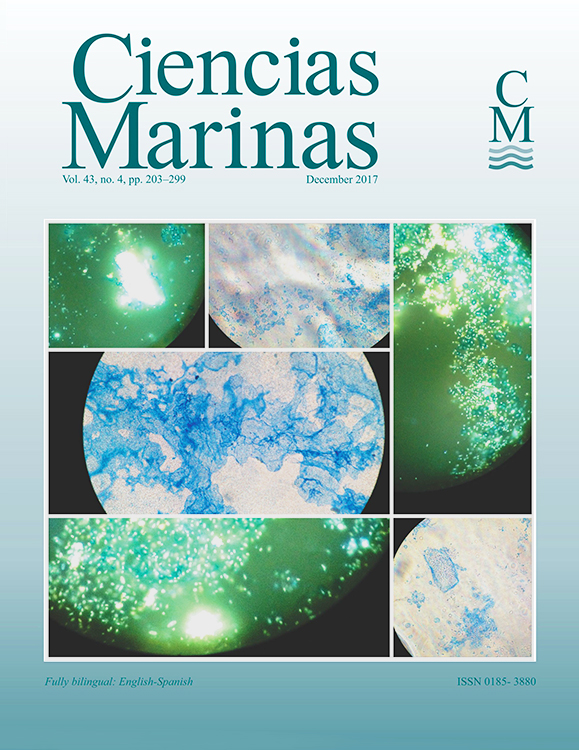Satellite-derived phytoplankton biomass and production variability in 2 contrasting coastal areas: off southern California and off northern Baja California
Main Article Content
Abstract
In order to compare phytoplankton biomass (satellite-derived chlorophyll, Chlsat) and production (PP), and sea surface temperature (SST) between the regions north and south of the Ensenada Front, time series were generated from satellite imagery for 250-km transects perpendicular to the coast: one off La Jolla (TLJ), southern California (USA), and the other off San Quintín Bay (TSQB), Baja California (Mexico). Moderate Resolution Imaging Spectroradiometer (MODIS) SST and Chlsat monthly composites and PP monthly composites were used for the 2002–2016 period. An “average year” was generated for each transect and each variable as an approximation to the climatology. Data show spatial variation in Chlsat and PP with higher values in the coastal zone (>10.0 mg·m–3 and >4.0 g C·m–2·d–1, respectively) than offshore (~0.1 mg·m–3 and 0.4 g C·m–2·d–1, respectively), while SST showed, in general, minimum values in the coastal zone (~15.0 ºC) and maxima offshore (~21.0 ºC). In the coastal zone, Chlsat values were higher on TSQB than on TLJ. However, sometimes phytoplankton biomass was higher in the offshore waters of TLJ than in the offshore waters of TSQB because of the effect of high Chlsat plumes coming from Point Conception into the Southern California Bight. The SST, Chlsat, and PP variations had clear seasonal and interannual components. Spectral analysis shows that the seasonal component of variation was dominant for the 3 variables. The 2004 central Pacific type of El Niño, the 2014 “Blob”, and the 2015–2016 eastern Pacific type of El Niño had very strong effects on phytoplankton biomass and production along both transects. Nevertheless, the effects generally tended to be stronger at TLJ than at TSQB. There are spatial variations in the coastal dynamics of the California Current System, and thus the effects of seasonal and interannual events will not be the same at different geographic locations.
Downloads
Article Details

This work is licensed under a Creative Commons Attribution 4.0 International License.
This is an open access article distributed under a Creative Commons Attribution 4.0 License, which allows you to share and adapt the work, as long as you give appropriate credit to the original author(s) and the source, provide a link to the Creative Commons license, and indicate if changes were made. Figures, tables and other elements in the article are included in the article’s CC BY 4.0 license, unless otherwise indicated. The journal title is protected by copyrights and not subject to this license. Full license deed can be viewed here.

